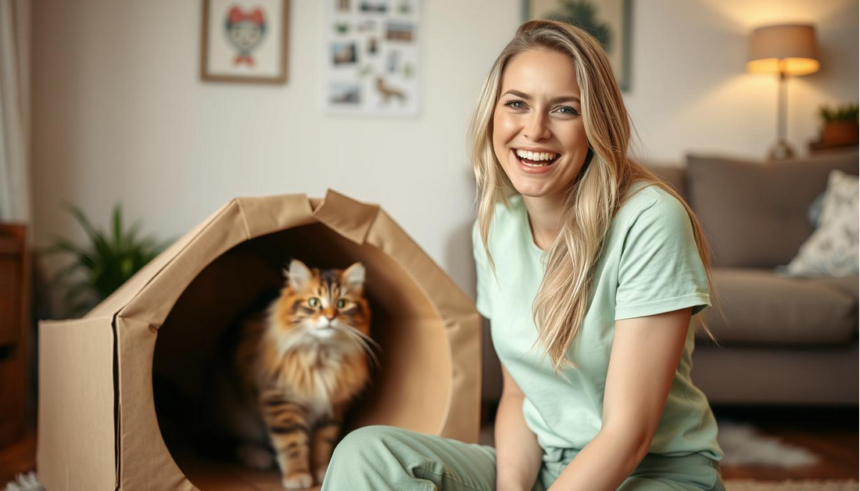India customers to view on amazon.in
Turning Cardboard Boxes Into Cat Playgrounds
Cats have a natural affinity for cardboard boxes, and with a little creativity, you can create a fun and stimulating DIY cardboard cat playground. Not only is this an eco-friendly way to reuse cardboard, but it also provides your feline friend with a unique play area.
- Why Cats Love Cardboard Boxes
- Benefits of DIY Cardboard Cat Playgrounds
- Environmental Benefits of Upcycling
- Cost-Effective Pet Entertainment
- Customizable to Your Cat’s Preferences
- Enrichment for Indoor Cats
- Essential Materials and Tools
- Types of Cardboard to Use
- Safe Cutting and Assembly Tools
- Pet-Safe Adhesives and Decorations
- Household Items You Can Repurpose
- Safety Considerations for Cardboard Cat Structures
- Avoiding Harmful Materials and Adhesives
- Structural Stability Tips
- When to Replace Your Cardboard Creations
- Supervision Guidelines for New Structures
- Simple Cardboard Box Cat House
- Basic Design Instructions
- Customization Options
- Adding Comfort Features
- Doorway and Window Placement Tips
- Creating Cardboard Cat Tunnels and Mazes
- Single Tunnel Design
- Complex Maze Construction
- Adding Interactive Elements
- Connecting Multiple Boxes for Extended Play
- Turning Cardboard Boxes Into Cat Playgrounds: Multi-Level Designs
- Planning Your Multi-Level Structure
- Construction Techniques
- Reinforcement Methods
- Creating Climbing and Jumping Opportunities
- DIY Cardboard Scratching Posts and Pads
- Vertical Scratching Post Design
- Horizontal Scratch Pad Options
- Combining with Other Playground Elements
- Extending the Life of Cardboard Scratchers
- Enhancing Your Cardboard Creations
- Adding Fabric and Soft Materials
- Incorporating Toys and Interactive Elements
- Decorating for Human Aesthetics
- Seasonal Themes and Variations
- Troubleshooting Common DIY Cat Playground Issues
- Fixing Structural Weaknesses
- Addressing Cat Disinterest
- Managing Multiple Cats and Playground Sharing
- Dealing with Excessive Chewing or Destruction
- Conclusion: Sustainable Fun for Your Feline Friend
- FAQ
- Why do cats love cardboard boxes so much?
- How can I make my cardboard cat playground more engaging?
- What types of cardboard are best for cat playgrounds?
- How can I ensure my cardboard cat playground is safe?
- Can I use cardboard cat playgrounds for multiple cats?
- How often should I replace my cardboard cat playground?
- Can I customize my cardboard cat playground to fit my home decor?
- Are cardboard cat playgrounds a cost-effective option?
- Can I create a cardboard cat playground for a kitten?
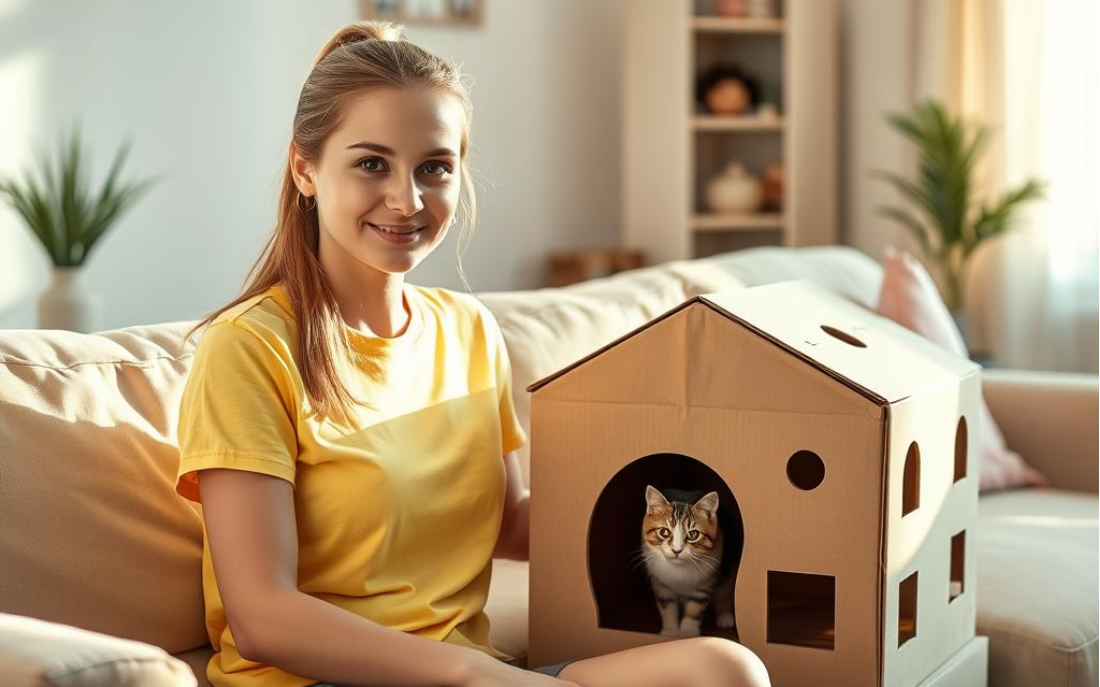
By transforming simple cardboard boxes into a homemade cat playground box, you can encourage your cat’s natural hunting instincts and provide them with a cozy space to relax. In this article, we’ll explore the benefits of creating a cardboard box cat house and provide step-by-step instructions to help you get started.
Key Takeaways
- Create a fun and stimulating play area for your cat using cardboard boxes.
- Encourage your cat’s natural hunting instincts with a DIY cardboard cat playground.
- Reuse cardboard to create an eco-friendly cat playground.
- Provide your cat with a cozy space to relax and hide.
- Get creative with your cardboard box designs to keep your cat engaged.
Why Cats Love Cardboard Boxes
Cardboard boxes seem to hold a special allure for cats, and understanding why can enrich our understanding of feline behavior. Cats are often drawn to these simple, everyday objects, and there are several reasons behind this attraction.
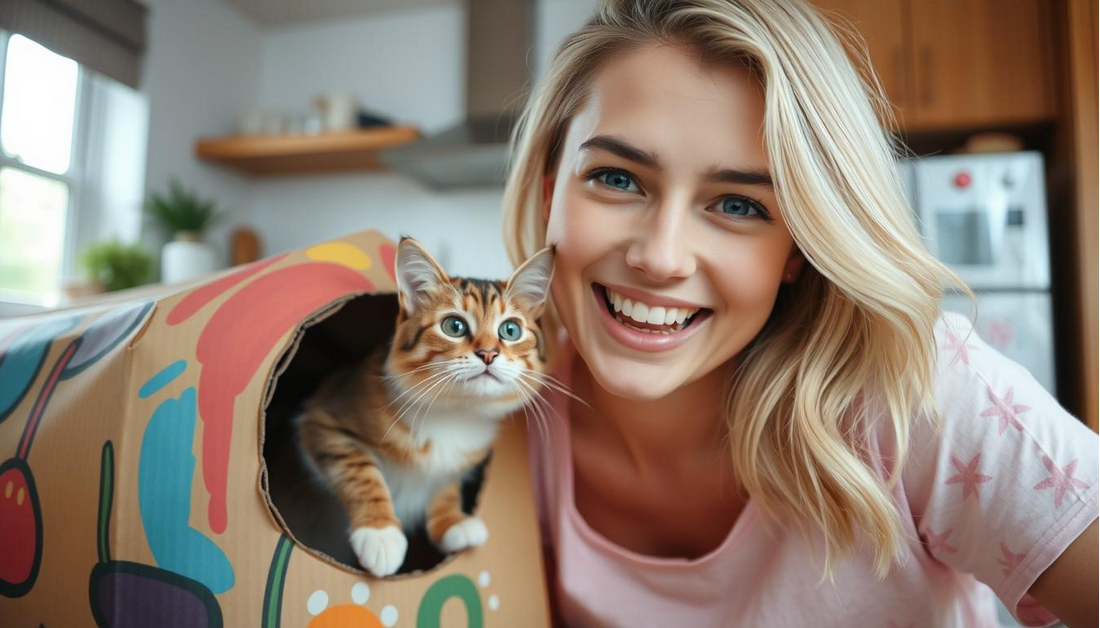
The Science Behind Cats and Boxes
Research suggests that cats are attracted to cardboard boxes due to their instinctual behavior. In the wild, cats often hide in enclosed spaces to stalk prey or avoid predators. The enclosed nature of a cardboard box provides a similar sense of security and comfort.
Security and Comfort Factors
The enclosed space of a cardboard box makes cats feel secure and protected. This is partly because the box provides a hiding place from the rest of the environment, allowing the cat to feel safe and relaxed. The comfort derived from being in a confined space is a natural behavior for many felines.
Natural Instincts and Hiding Behaviors
Cats are natural predators, and their instinct is to hide and stalk. Cardboard boxes satisfy this instinct by providing a hiding place. Some key reasons include:
- The box acts as a shelter, making the cat feel protected.
- It allows cats to observe their surroundings without being seen.
- The enclosed space can be very comforting for cats, much like a den.
By understanding these factors, cat owners can enrich their cat’s life with simple DIY toys like cardboard boxes, promoting stimulating indoor cat play.
Benefits of DIY Cardboard Cat Playgrounds
Upcycling cardboard boxes into cat playgrounds offers numerous benefits for both cats and their owners. By repurposing cardboard, you’re not only reducing waste but also creating a unique and engaging environment for your feline friend.
Environmental Benefits of Upcycling
One of the significant advantages of DIY cardboard cat playgrounds is their positive impact on the environment. By upcycling cardboard boxes, you’re diverting waste from landfills and reducing the need for new, resource-intensive materials. This eco-friendly approach to pet entertainment aligns with the growing trend of eco cat toys from recycled boxes, promoting sustainability in pet care.
Cost-Effective Pet Entertainment
Creating a cardboard cat playground is a cheap cat enrichment idea that doesn’t compromise on fun. Using materials you likely have at home, such as cardboard boxes, you can create complex and engaging playgrounds without spending a fortune. This approach is particularly appealing to pet owners looking for zero-cost cat toy solutions.
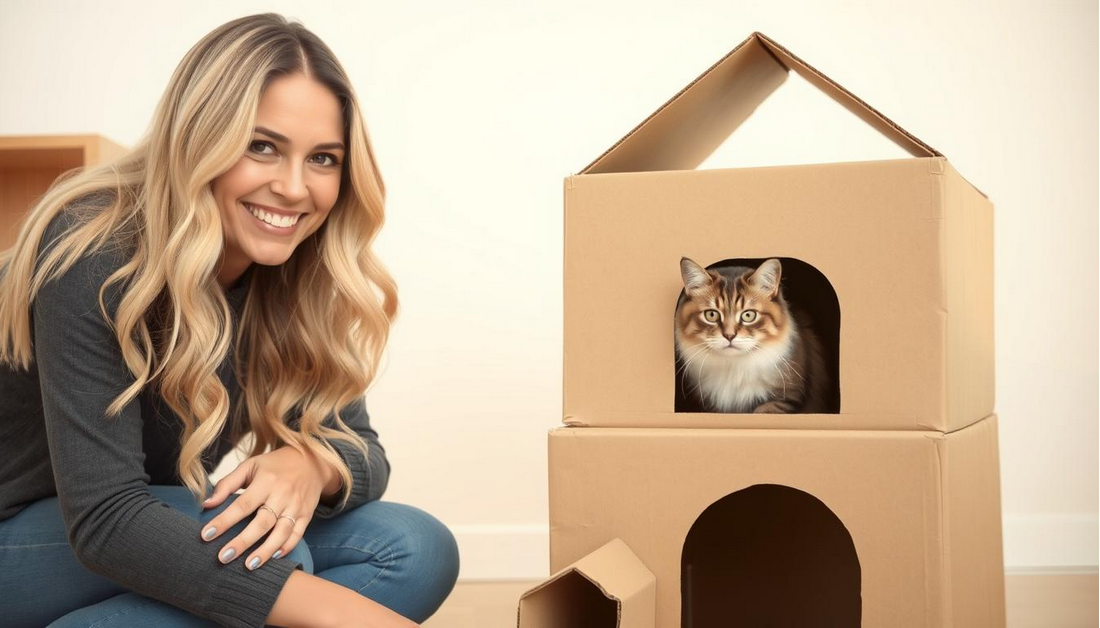
Customizable to Your Cat’s Preferences
A significant benefit of DIY cardboard cat playgrounds is their customizability. You can design the playground according to your cat’s preferences, whether they enjoy hiding in enclosures, scratching surfaces, or navigating through tunnels. This flexibility allows you to create a truly personalized sustainable diy cat playground.
Enrichment for Indoor Cats
Indoor cats, in particular, benefit from cardboard cat playgrounds as they provide much-needed mental and physical stimulation. By reusing packaging for cat fun, you’re not only entertaining your cat but also contributing to their overall well-being by reducing boredom and encouraging natural behaviors.
Essential Materials and Tools
Before you start creating a cardboard cat playground, it’s crucial to gather the necessary materials and tools. Having the right supplies will ensure your project is fun, safe, and engaging for your cat.
Types of Cardboard to Use
When it comes to selecting cardboard for your cat’s playground, sturdy boxes are ideal. Consider using boxes from appliances or furniture as they are typically strong and large enough for cats to play in. You can also repurpose file storage boxes or large shipping boxes.
Safe Cutting and Assembly Tools
To cut and assemble the cardboard, you’ll need some basic tools. Use a utility knife or scissors to cut the cardboard. For assembly, consider using tape or a hot glue gun, but be cautious with the hot glue gun as it can be dangerous for pets if not used properly.
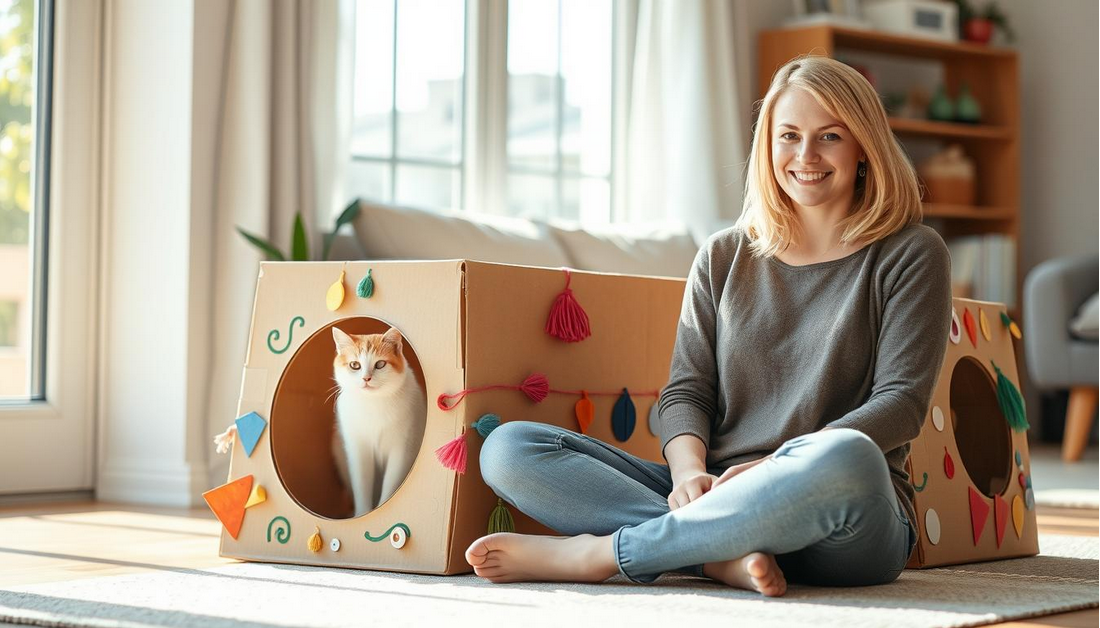
Pet-Safe Adhesives and Decorations
When decorating or assembling your cardboard cat playground, ensure that all adhesives and decorations are pet-safe. Avoid using materials that can be toxic to cats, such as certain glues or paints. Instead, opt for non-toxic alternatives.
Household Items You Can Repurpose
Many household items can be repurposed to enhance your cardboard cat playground. Consider using old blankets or towels to create cozy hiding spots, or incorporating cat toys to make the playground more engaging.
Safety Considerations for Cardboard Cat Structures
Creating a safe environment for your cat to play in their cardboard playground is essential for their well-being. While cardboard cat structures are generally safe, there are some safety considerations to keep in mind to prevent any harm to your feline friend.
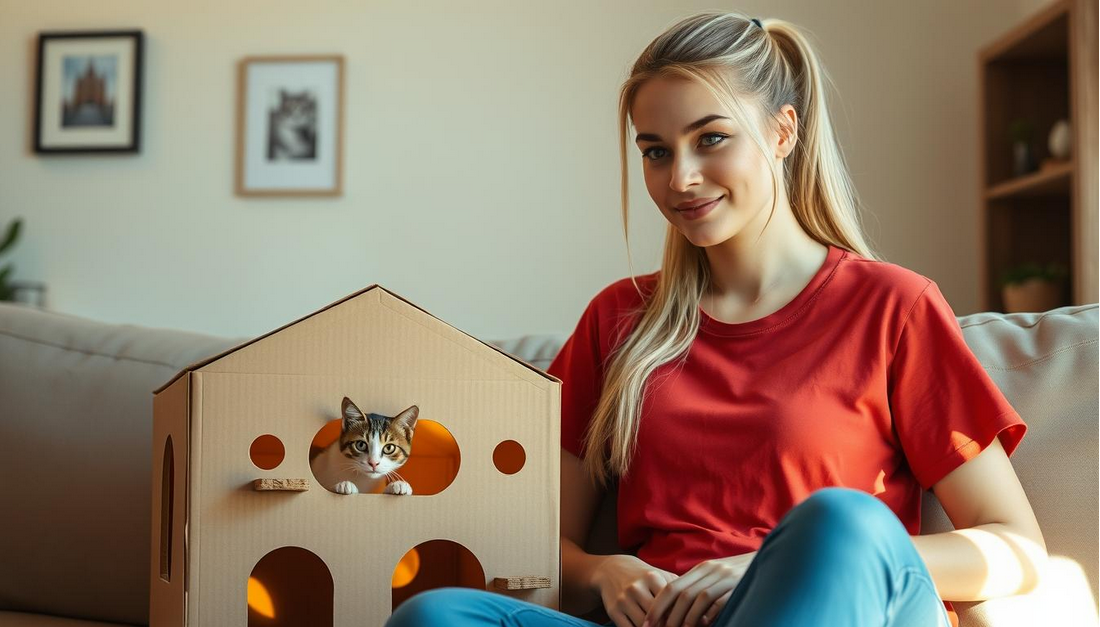
Avoiding Harmful Materials and Adhesives
When building your cardboard cat playground, it’s crucial to avoid using harmful materials and adhesives that could be toxic to your cat. Choose pet-safe materials and adhesives that are non-toxic and safe for your cat to chew on or ingest in case of accidental ingestion.
Structural Stability Tips
To prevent your cardboard structure from collapsing, ensure it is stable and sturdy. Use sturdy cardboard and reinforce the structure with tape or other pet-safe materials. Make sure the base is wide enough to prevent the structure from tipping over.
When to Replace Your Cardboard Creations
Regularly inspect your cardboard cat playground for signs of wear and tear. Replace the structure if it becomes damaged or worn out to prevent any harm to your cat. Monitor your cat’s behavior and replace the structure if you notice any changes in their interaction with it.
Supervision Guidelines for New Structures
When introducing a new cardboard structure to your cat, supervise their interaction closely. Watch for any signs of distress or fear, and remove the structure if you notice any adverse reactions. Gradually introduce the structure to your cat’s environment to prevent overwhelming them.
By following these safety considerations, you can create a fun and safe cardboard cat playground for your feline friend to enjoy.
Simple Cardboard Box Cat House
With just a few simple steps, you can transform a cardboard box into a delightful cat house that your pet will love. This project is not only fun but also provides your cat with a cozy retreat.
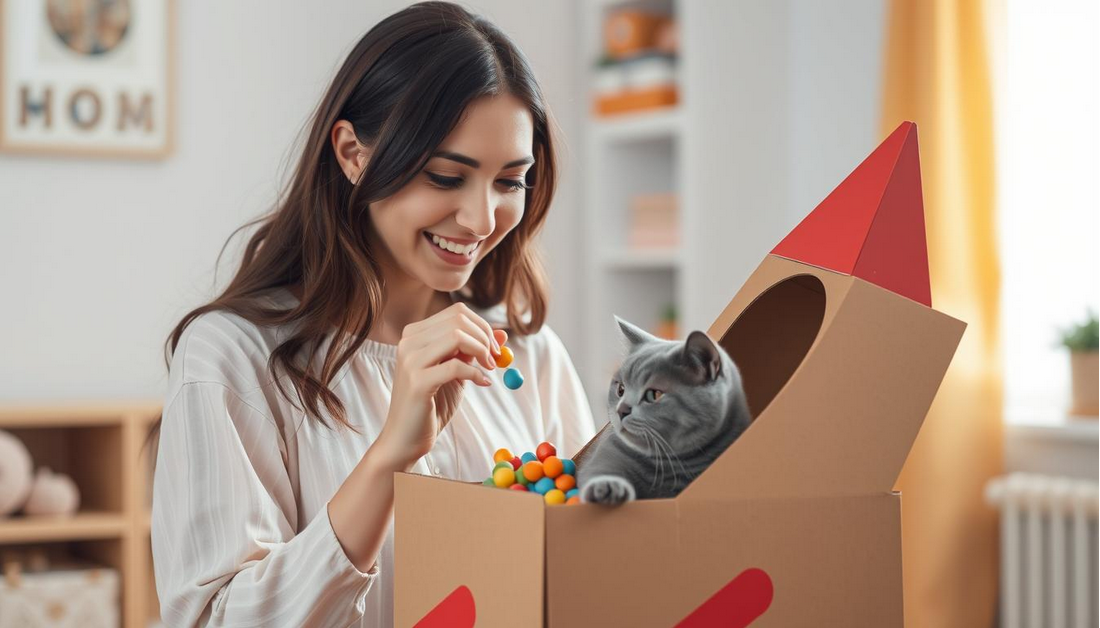
Basic Design Instructions
To start, select a sturdy cardboard box that’s large enough for your cat to comfortably enter and exit. Remove any plastic or foam inserts and cut out doorway openings on one or more sides, depending on your design.
Ensure the doorway is low enough for your cat to easily step in and out but not so low that it touches the ground. You can also cut out windows for ventilation and to allow natural light in.
Customization Options
You can personalize the cat house by decorating it with cat-safe materials like paper bags, cardboard tubes, or even fabric scraps. Consider adding a roof or additional levels to make it more appealing.
Adding Comfort Features
To make the cat house more inviting, you can add a soft blanket or towel inside. Some cats also enjoy having toys or scratching posts near their hideaways.
Doorway and Window Placement Tips
When deciding on doorway and window placements, consider your cat’s preferences. Some cats like having multiple exits, while others prefer a single entrance. Observe your cat’s behavior to determine the best configuration.
Creating Cardboard Cat Tunnels and Mazes
Transforming cardboard boxes into tunnels and mazes can be a fun and creative way to engage your cat’s natural hunting instincts. Cats are naturally curious creatures, and complex cardboard structures can provide them with the mental and physical stimulation they need.
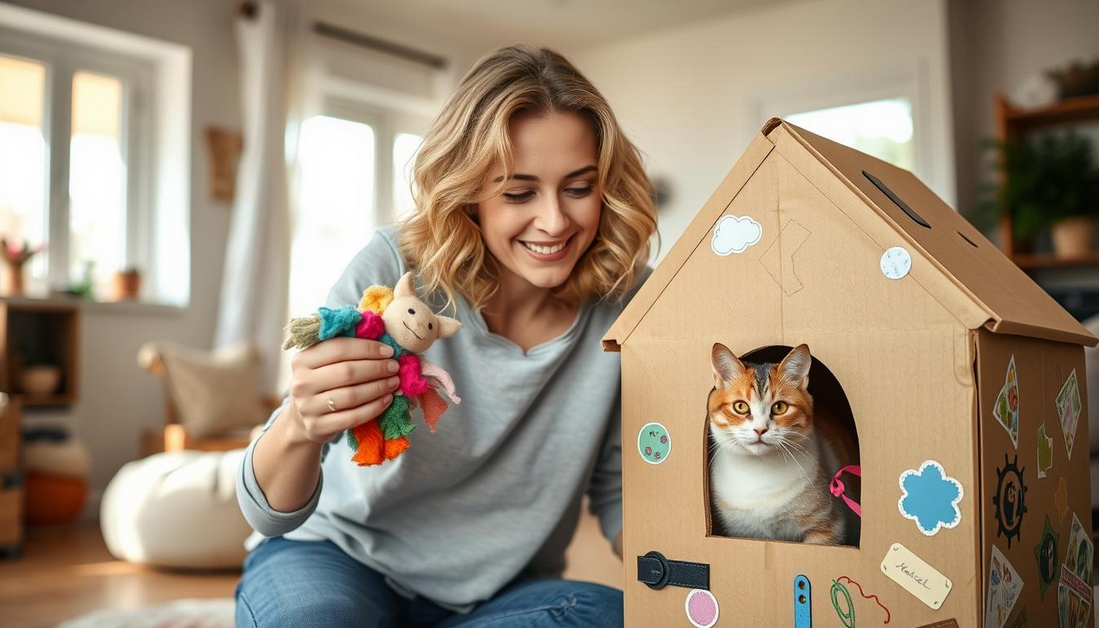
Single Tunnel Design
A simple yet effective way to start is by creating a single cardboard cat tunnel. This can be achieved by cutting holes of varying sizes in a large cardboard box and then turning it into a tunnel shape. You can secure the shape with pet-safe adhesives or tape.
Complex Maze Construction
For a more challenging project, you can construct a complex DIY cat maze by connecting multiple boxes. Cut holes in strategic locations to create a maze that requires your cat to navigate through different paths. This not only entertains your cat but also provides exercise.
Adding Interactive Elements
To make your cardboard creations even more engaging, consider adding interactive cat toys. You can place toys or treats inside the tunnels or maze, encouraging your cat to explore and hunt. This interaction can help reduce boredom and stimulate your cat’s natural behaviors.
Connecting Multiple Boxes for Extended Play
By connecting multiple cardboard boxes, you can create an extensive network of tunnels and chambers. This allows your cat to enjoy extended play sessions, moving from one box to another through the connected tunnels. It’s a great way to keep your cat entertained for hours.
In conclusion, creating cardboard cat tunnels and mazes is a simple and cost-effective way to provide your cat with entertainment and stimulation. With a little creativity, you can design complex structures that will keep your cat engaged and active.
Turning Cardboard Boxes Into Cat Playgrounds: Multi-Level Designs
Transforming cardboard boxes into a multi-level cat playground can provide your pet with endless entertainment. This project not only challenges your cat physically but also stimulates their natural curiosity.
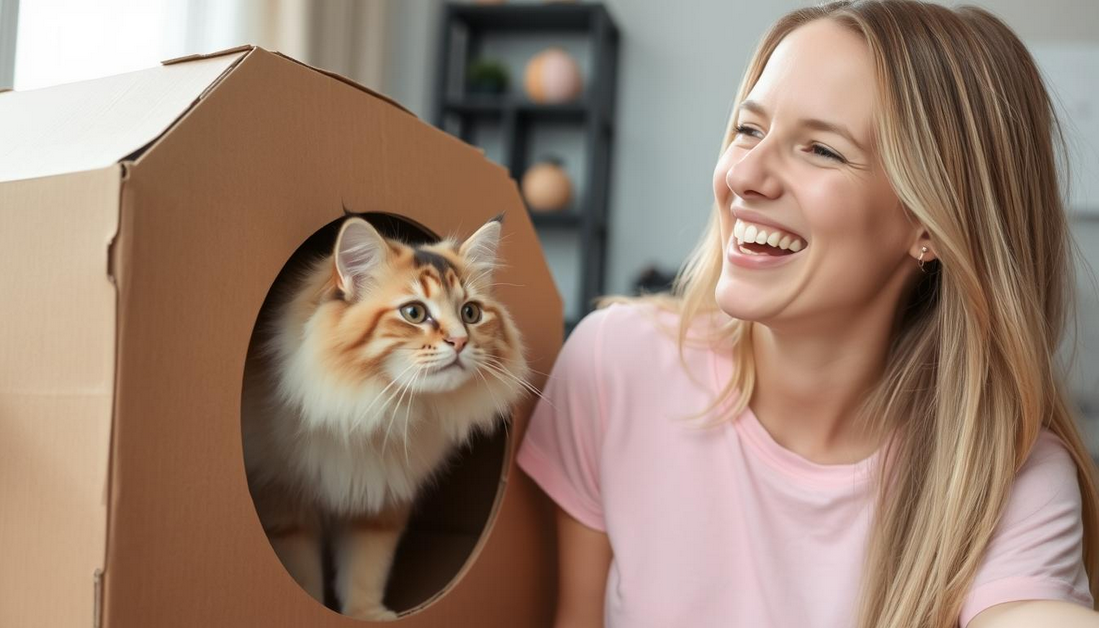
Planning Your Multi-Level Structure
Before you start building, it’s essential to plan your multi-level cat playground carefully. Consider the space available in your home and the size of your cat. Think about the different levels and how they will be connected.
Sketch out a basic design, taking into account the number of boxes you’ll need and how you’ll secure them together. Ensure that your structure won’t be too tall or unstable.
Construction Techniques
When constructing your multi-level cat playground, you’ll need to cut and assemble the cardboard boxes. Use safe cutting tools and consider using pet-safe adhesives to hold the structure together.
Key construction tips:
- Cut holes of varying sizes to create windows and doorways.
- Use tape or glue to secure boxes together.
- Ensure the structure is stable before introducing it to your cat.
Reinforcement Methods
To make your DIY cat jungle gym more durable, consider reinforcement methods. Distributing the weight evenly across the structure is crucial.
Weight Distribution Considerations
Ensure that the base of your cat climbing structure is sturdy and wide enough to support the weight of the upper levels.
Connecting Multiple Boxes Securely
Use strong tape or non-toxic glue to connect the boxes. You can also use additional support materials like wooden dowels or PVC pipes for added stability.
Creating Climbing and Jumping Opportunities
A cardboard cat tower should provide ample opportunities for climbing and jumping. Create different levels and inclines to challenge your cat and keep them active.
Consider adding ramps or inclined planes to connect different levels, allowing your cat to climb up and down easily.
DIY Cardboard Scratching Posts and Pads
Transforming cardboard into a scratching post is not only a creative project but also a practical solution for your feline friend. Cats need to scratch to maintain their nail health, stretch their muscles, and mark their territory. By creating a DIY cardboard scratching post or pad, you can provide your cat with a satisfying outlet for these natural behaviors.
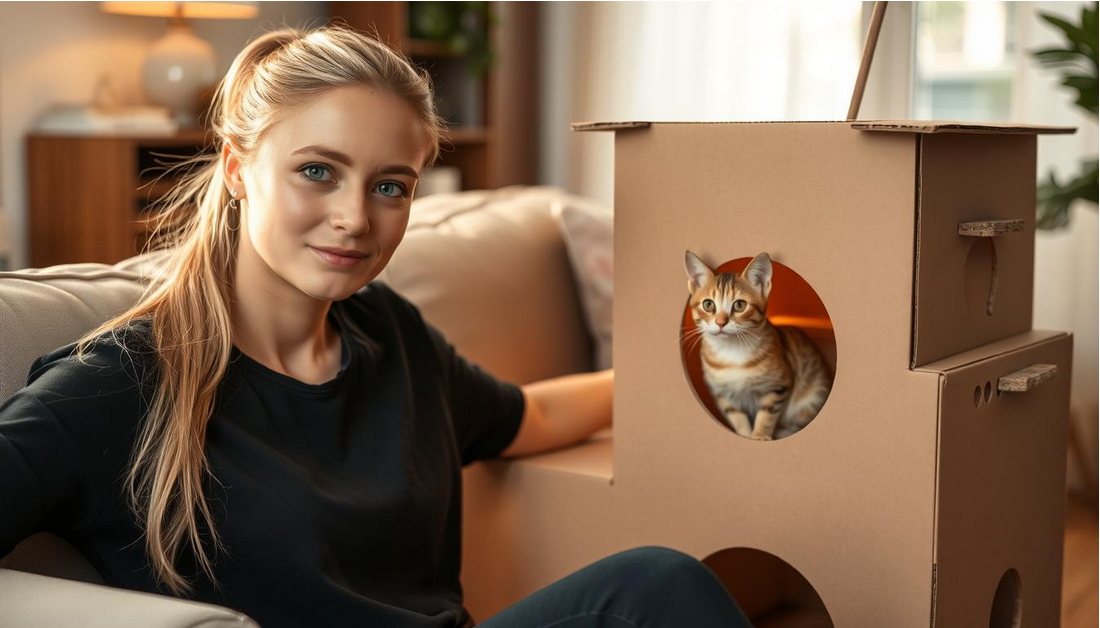
Vertical Scratching Post Design
A vertical scratching post can be made by wrapping cardboard around a central core, such as a paper towel roll or a piece of PVC pipe, to create a sturdy column. Secure the cardboard with pet-safe adhesives or tape to ensure it doesn’t unravel. You can also add texture by layering different types of cardboard or incorporating other materials like sisal rope.
Horizontal Scratch Pad Options
For cats who prefer scratching horizontally, a simple scratch pad can be created by flattening a large cardboard box and cutting it to the desired size. You can enhance the scratching surface by gluing a piece of cardboard with a corrugated surface or adding a layer of sisal fabric.
Combining with Other Playground Elements
Cardboard scratching posts and pads can be integrated with other DIY cardboard cat playground elements to create a comprehensive play area. For example, you can attach a scratching pad to the side of a cardboard box house or incorporate scratching surfaces into a multi-level cardboard structure.
Extending the Life of Cardboard Scratchers
To extend the life of your cardboard scratching post or pad, place it in a dry area away from direct sunlight, which can cause the cardboard to degrade. You can also reinforce the structure with additional layers of cardboard or tape. Regularly inspect the scratcher for signs of wear and tear, and replace it as needed to keep your cat engaged and satisfied.
Enhancing Your Cardboard Creations
Cardboard is just the beginning; you can significantly enhance your cat’s playground with some creative additions. By incorporating various elements, you can create a more engaging and stimulating environment for your feline friend.
Adding Fabric and Soft Materials
One way to enhance your cardboard creations is by adding fabric and soft materials. Cats often prefer to scratch, rub, and lie on soft surfaces, making fabric a great addition. You can wrap cardboard structures with fabric or add soft cushions inside the boxes.
Incorporating Toys and Interactive Elements
To make your cardboard cat playground more engaging, consider incorporating toys and interactive elements. Attach toys to the cardboard structures or hang them inside the boxes to encourage playful behavior. You can also add interactive elements like bells or scratching pads.
Decorating for Human Aesthetics
While cats may not care about the aesthetics of their playground, their owners often do. Decorating your cardboard creations to match your home decor can make them more appealing. Use pet-safe materials and colors that blend with your interior design.
Seasonal Themes and Variations
To keep your cat engaged, you can create seasonal themes and variations for their playground. For example, you can add Christmas-themed toys or Halloween decorations to the cardboard structures. This not only provides a change of pace for your cat but also adds a fun element for you and your family.
As “Cats are highly sensitive to their environment”, as noted by cat behaviorists, making these enhancements can significantly improve your cat’s quality of life. By following these tips, you can create a cardboard cat playground that is both fun and functional for your feline companion.
Troubleshooting Common DIY Cat Playground Issues
As fun as building a DIY cat playground can be, it’s not without its potential problems. Whether it’s structural weaknesses, cat disinterest, or excessive chewing, being prepared to troubleshoot these issues can ensure your cat’s playground remains a fun and safe space.
Fixing Structural Weaknesses
One common issue with DIY cat playgrounds is structural weakness. To fix this, reinforce the structure with additional tape or glue, and ensure that the base is sturdy. You can also add support beams or brackets to enhance stability.
Addressing Cat Disinterest
If your cat seems disinterested in the playground, try adding new toys or interactive elements. Cats can get bored just like humans, so rotating toys or adding new features can help keep them engaged.
Managing Multiple Cats and Playground Sharing
For households with multiple cats, managing playground sharing is crucial. Ensure there are multiple entry and exit points to reduce competition. You can also create separate areas or levels within the playground to accommodate multiple cats.
Dealing with Excessive Chewing or Destruction
Excessive chewing or destruction can be a problem if cats are not provided with appropriate alternatives. Provide cat-safe chewing toys and consider using deterrents like double-sided tape on surfaces you don’t want them to chew.
| Issue | Solution |
|---|---|
| Structural Weakness | Reinforce with tape or glue, add support beams |
| Cat Disinterest | Add new toys or interactive elements |
| Multiple Cats | Create separate areas or levels, multiple entry/exit points |
| Excessive Chewing | Provide cat-safe chewing toys, use deterrents |
Conclusion: Sustainable Fun for Your Feline Friend
By creating a diy cat playground using cardboard boxes, cat owners can provide their feline friends with a stimulating environment that encourages natural behavior and exercise. This eco-friendly approach not only reduces waste but also offers a cost-effective way to enrich your cat’s life.
A sustainable cat playground made from cardboard can be a haven for your cat, providing them with a sense of security and comfort. You can further enhance this experience by incorporating eco-friendly cat toys and other enrichment ideas.
The flexibility of diy cat playground designs allows you to tailor the structure to your cat’s preferences, ensuring they remain engaged and active. As you’ve seen throughout this article, with a little creativity, you can turn ordinary cardboard boxes into an exciting and dynamic playground.
Embracing this creative and environmentally conscious approach to cat enrichment can lead to a happier, healthier feline companion. So, gather those cardboard boxes and start building a fun and sustainable cat playground for your feline friend today!
FAQ
Why do cats love cardboard boxes so much?
Cats are drawn to cardboard boxes because they provide a sense of security, comfort, and a place to hide and relax. The enclosed space allows them to feel safe and protected, and the cardboard material is often appealing to their natural instinct to scratch and rub.
How can I make my cardboard cat playground more engaging?
You can enhance your cardboard cat playground by adding interactive elements like toys, scratching posts, and dangling objects. You can also incorporate different textures, such as fabric or carpet, to make the space more appealing to your cat.
What types of cardboard are best for cat playgrounds?
Sturdy, corrugated cardboard is ideal for cat playgrounds because it is durable and can withstand scratching and rubbing. Avoid using thin or flimsy cardboard, as it may not be able to support your cat’s weight or activity.
How can I ensure my cardboard cat playground is safe?
To ensure your cardboard cat playground is safe, avoid using harmful materials or adhesives, and make sure the structure is stable and secure. Supervise your cat when introducing new structures, and replace any damaged or worn-out components.
Can I use cardboard cat playgrounds for multiple cats?
Yes, cardboard cat playgrounds can be used for multiple cats, but it’s essential to ensure the structure is sturdy enough to accommodate multiple users. You may need to reinforce the playground or create separate areas for each cat to prevent conflicts.
How often should I replace my cardboard cat playground?
The lifespan of a cardboard cat playground depends on usage and maintenance. Inspect the structure regularly, and replace it when it becomes worn out or damaged. You can also rotate different cardboard creations to keep your cat engaged and interested.
Can I customize my cardboard cat playground to fit my home decor?
Yes, you can customize your cardboard cat playground to fit your home decor by incorporating decorative elements, such as fabric or paint, that match your interior design. This can help the playground blend in with your home’s aesthetic.
Are cardboard cat playgrounds a cost-effective option?
Yes, cardboard cat playgrounds are a cost-effective option because they are made from readily available, inexpensive materials. You can repurpose cardboard boxes and other household items to create a fun and engaging playground for your cat.
Can I create a cardboard cat playground for a kitten?
Yes, you can create a cardboard cat playground for a kitten, but be sure to use safe and sturdy materials, and supervise your kitten during playtime. Kittens are naturally curious, so it’s essential to ensure the playground is secure and free from hazards.

